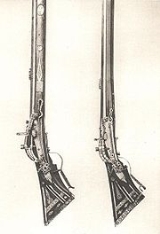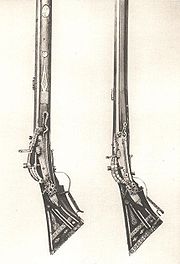
Snaphance
Encyclopedia

Flintlock
Flintlock is the general term for any firearm based on the flintlock mechanism. The term may also apply to the mechanism itself. Introduced at the beginning of the 17th century, the flintlock rapidly replaced earlier firearm-ignition technologies, such as the doglock, matchlock and wheellock...
firing mechanism. It fires from a flint struck against a striker plate above a steel pan to ignite the priming powder which fires the gun. Examples of this firearm can be found through Europe, North Africa, and the Middle East.
Design
Like the earlier snaplock
Snaplock
A Snaplock is a particular type of mechanism for firing a gun .A snaplock ignites the weapon's propellant by means of sparks produced when a spring-powered cock strikes a flint down on to a piece of hardened steel...
and later flintlock, the snaphance drives a flint onto a steel to create a shower of sparks to ignite the main charge (propellant).
The flint
Flint
Flint is a hard, sedimentary cryptocrystalline form of the mineral quartz, categorized as a variety of chert. It occurs chiefly as nodules and masses in sedimentary rocks, such as chalks and limestones. Inside the nodule, flint is usually dark grey, black, green, white, or brown in colour, and...
is held in a clamp at the end of a bent lever called the cock. Upon pulling the trigger, this moves forward under the pressure of a strong spring and strikes a curved plate of hardened steel (called simply the steel, or in 17th century English dialect the frizzen
Frizzen
The frizzen, historically called the steel, is an "L" shaped piece of steel hinged at the rear used in flintlock firearms. It is positioned over the flash pan so as to enclose a small priming charge of black powder next to the flash hole that is drilled through the barrel into where the main...
) to produce a shower of sparks (actually white-hot steel shavings). These fall into a flash pan
Flash pan
The flash pan or priming pan is a small receptacle for priming powder, found next to the touch hole on muzzleloading guns. Flash pans are found on gonnes, matchlocks, wheellocks, snaplocks, snaphances, and flintlocks....
holding priming powder. The flash from the pan travels through the touch hole
Touch hole
A touch hole is a small hole, through which the propellant charge of a cannon or muzzleloading gun is ignited. In small arms, the flash from a charge of priming held in the flash pan is enough to ignite the charge within...
to cause the main charge of gunpowder
Gunpowder
Gunpowder, also known since in the late 19th century as black powder, was the first chemical explosive and the only one known until the mid 1800s. It is a mixture of sulfur, charcoal, and potassium nitrate - with the sulfur and charcoal acting as fuels, while the saltpeter works as an oxidizer...
to explode
Explosion
An explosion is a rapid increase in volume and release of energy in an extreme manner, usually with the generation of high temperatures and the release of gases. An explosion creates a shock wave. If the shock wave is a supersonic detonation, then the source of the blast is called a "high explosive"...
.
The snaphance first appeared in the late 1550s as a development of the earlier snaplock
Snaplock
A Snaplock is a particular type of mechanism for firing a gun .A snaplock ignites the weapon's propellant by means of sparks produced when a spring-powered cock strikes a flint down on to a piece of hardened steel...
. The main improvement was that the pan-cover opened automatically (to keep the priming dry until the exact moment of firing), as in the wheel-lock. (The snaplock had a manually operated pan cover similar to that of the matchlock
Matchlock
The matchlock was the first mechanism, or "lock" invented to facilitate the firing of a hand-held firearm. This design removed the need to lower by hand a lit match into the weapon's flash pan and made it possible to have both hands free to keep a firm grip on the weapon at the moment of firing,...
. Some definitions class the snaphaunce as a sub-type of snaplock.) Also like the wheel-lock, the snaphance used a lateral sear
Sear (firearm)
In a firearm, the sear is the part of the trigger mechanism which holds the hammer or striker back until the correct amount of pressure has been applied to the trigger; at which point the hammer or striker is released to discharge the weapon...
mechanism to connect trigger to cock. Later models had a variety of safety mechanisms to prevent accidental discharge of the gun. Without these the weapons could be highly dangerous: Hakluyt's "Voyages" records the death of one of the men on Cavendish's circumnavigation in the 1580s due to an accidental discharge during a hurried re-embarkation on the coast of Ecuador.
Use
The snaphance was used from the late 1550s until modern times (in North African guns), but by about 1680 it was out of fashion everywhere except Northern Italy where it persisted until the 1750s. In Europe, and especially FranceFrance
The French Republic , The French Republic , The French Republic , (commonly known as France , is a unitary semi-presidential republic in Western Europe with several overseas territories and islands located on other continents and in the Indian, Pacific, and Atlantic oceans. Metropolitan France...
, the snaphance was replaced by the flintlock
Flintlock
Flintlock is the general term for any firearm based on the flintlock mechanism. The term may also apply to the mechanism itself. Introduced at the beginning of the 17th century, the flintlock rapidly replaced earlier firearm-ignition technologies, such as the doglock, matchlock and wheellock...
with its combined steel/pan cover starting from about 1620. In England, a hybrid mechanism called the English Lock replaced the snaphance from the same date. Both the flintlock and the English lock were cheaper and less complex than the snaphance.
Name
The origin of the name snaphance is thought to come from the Dutch languageDutch language
Dutch is a West Germanic language and the native language of the majority of the population of the Netherlands, Belgium, and Suriname, the three member states of the Dutch Language Union. Most speakers live in the European Union, where it is a first language for about 23 million and a second...
"Snap Haan" or German language
German language
German is a West Germanic language, related to and classified alongside English and Dutch. With an estimated 90 – 98 million native speakers, German is one of the world's major languages and is the most widely-spoken first language in the European Union....
"Schnapphahn"—both of which roughly mean "cock peck" or "snapping lever", and could relate to the shape of the mechanism and its downward-darting action (and would also explain the name "cock" for the beak-shaped mechanism which holds the flint). A more fanciful explanation relates to the use of this type of gun by chicken thieves, who would be given away by the sight and smell of a burning match if they had used the earlier matchlock gun in their nocturnal depredations. The German word Schnapphahn had however since moved away from the earlier definitions and has traditionally referred to a mounted highwayman
Highwayman
A highwayman was a thief and brigand who preyed on travellers. This type of outlaw, usually, travelled and robbed by horse, as compared to a footpad who traveled and robbed on foot. Mounted robbers were widely considered to be socially superior to footpads...
, who would have been likely to use a firearm
Firearm
A firearm is a weapon that launches one, or many, projectile at high velocity through confined burning of a propellant. This subsonic burning process is technically known as deflagration, as opposed to supersonic combustion known as a detonation. In older firearms, the propellant was typically...
of that nature. The French chenapan also changed its meaning in the seventeenth century to define a rogue or scoundrel. During the Second Northern
Second Northern War
The Second Northern War was fought between Sweden and its adversaries the Polish–Lithuanian Commonwealth , Russia , Brandenburg-Prussia , the Habsburg Monarchy and Denmark–Norway...
and Scanian War
Scanian War
The Scanian War was a part of the Northern Wars involving the union of Denmark-Norway, Brandenburg and Sweden. It was fought mainly on Scanian soil, in the former Danish provinces along the border with Sweden and in Northern Germany...
s, a "Snapphane
Snapphane
A snapphane was a member of a 17th century pro-Danish guerrilla organization that fought against the Swedes in the Second Northern and Scanian Wars, primarily in the former eastern Danish provinces which in the course of these wars became southern Sweden....
" was a pro-Danish Guerilla-man in Scania, which had just been annexed by Sweden, as they wanted to belong to Denmark instead.
In Swedish the word Snapphane is first recorded 1558 in a letter from King Gustav I
Gustav I of Sweden
Gustav I of Sweden, born Gustav Eriksson of the Vasa noble family and later known simply as Gustav Vasa , was King of Sweden from 1523 until his death....
to his son Duke John of Finland
John III of Sweden
-Family:John married his first wife, Catherine Jagellonica of Poland , house of Jagiello, in Vilnius on 4 October 1562. In Sweden, she is known as Katarina Jagellonica. She was the sister of king Sigismund II Augustus of Poland...
"reffvelske snaphaner" (Snapphanar from Tallinn-Reval), earlier correspondence were discussing Estonian privateers and problems created by them in Russian commerce. In the inventories of the Royal Armoury in Stockholm the term snapphanelås (snaphance lock) appears first in 1730, after the conquest of the former Danish provinces of Skåne, Halland and Blekinge in 1670s. The local peasant warriors were then called snapphanar and their typical smallbore rifles (see picture) were described as having snapphanelås: locks or rifles used by the Snapphanar. In the earlier inventories the term used is always snapplås (snaplock).
See also
- Caplock mechanismCaplock mechanismThe caplock mechanism or "percussion" lock was the successor of the flintlock mechanism in firearm technology, and used a percussion cap struck by the hammer to set off the main charge, rather than using a piece of flint to strike a steel frizzen....
- FlintlockFlintlockFlintlock is the general term for any firearm based on the flintlock mechanism. The term may also apply to the mechanism itself. Introduced at the beginning of the 17th century, the flintlock rapidly replaced earlier firearm-ignition technologies, such as the doglock, matchlock and wheellock...
- Hand cannon
- MatchlockMatchlockThe matchlock was the first mechanism, or "lock" invented to facilitate the firing of a hand-held firearm. This design removed the need to lower by hand a lit match into the weapon's flash pan and made it possible to have both hands free to keep a firm grip on the weapon at the moment of firing,...
- MiqueletMiqueletMiquelet Lock is a modern collector/auctioneer/curator term, largely used by and for the benefit of the English speaking world, widely applied to a distinctive form of snaplock, originally as a flint-against-steel ignition form, prevalent in the Iberian, Italian, and Balkan peninsulas, North...
- Percussion capPercussion capThe percussion cap, introduced around 1830, was the crucial invention that enabled muzzleloading firearms to fire reliably in any weather.Before this development, firearms used flintlock ignition systems which produced flint-on-steel sparks to ignite a pan of priming powder and thereby fire the...
- SnaplockSnaplockA Snaplock is a particular type of mechanism for firing a gun .A snaplock ignites the weapon's propellant by means of sparks produced when a spring-powered cock strikes a flint down on to a piece of hardened steel...
- WheellockWheellockA wheellock, wheel-lock or wheel lock, is a friction-wheel mechanism to cause a spark for firing a firearm. It was the next major development in firearms technology after the matchlock and the first self-igniting firearm. The mechanism is so-called because it uses a rotating steel wheel to provide...

